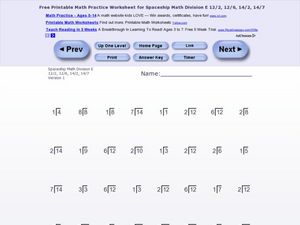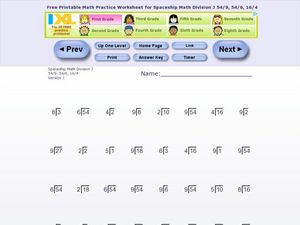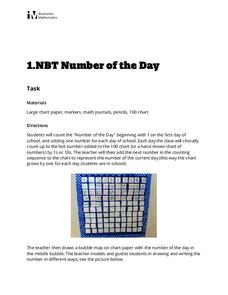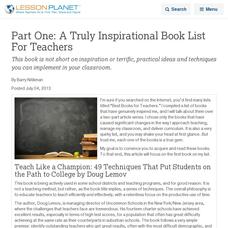Curated OER
LESS THAN ZERO
Upper graders study how to extend a vertical number line to include negative numbers; order numbers on the number line; and find the distance between numbers on a number line. They will begin with a game using dice to explore...
University of Tennessee
Note-Taking Skills (Cornell)
Taking good notes is key to success in academic classes. How to take good notes is the focus of this five-page packet that introduces the Cornell, the Five R's, and the SQ3R methods of note taking in one study skills lesson.
Scholastic
Making the Times Table Mini-Books
What do you get when you combine your traditional times table worksheet with cute worm characters? A fun mini-book that youngsters can enjoy and that will help them practice multiplying by one!
EngageNY
Conditions for a Unique Triangle—Two Angles and a Given Side
Using patty paper, classes determine that only one triangle is possible when given two specific angle measures and a side length. As the 10th instructional activity in the series of 29, young math scholars add these criteria to those...
PBS
Remove One
With a set of 15 chips and a number line, learners predict what sums may occur with the rolling of two dice. When their sum comes up, they remove one of the chips from their number line with the objective of being the first to remove...
Curated OER
What's That Number? 1-Digit Addition and Subtraction
In this subtraction and addition worksheet, young scholars fill in missing numbers in problems necessary to arrive at given answers. All problems use 1-digit numbers only.
Curated OER
Divide By One-Digit Numbers
In this finding the quotients learning exercise, students divide one-digit and two-digit numbers by one-digit numbers with no remainders. Students solve 40 problems.
Curated OER
Divide Two-Digits by One-Digit 1
In this finding the quotients worksheet, 3rd graders divide two-digit numbers by one-digit numbers with no remainders. Students solve 40 problems.
Curated OER
Addition: Number Bonds to 30
In this addition worksheet, students fill in the missing addend to an addition problem that adds up to 30. This number could be a one or two digit number. Students complete 41 missing addend problems.
Curated OER
More Than One Grain of Rice
Learners explore mathematics, geography and agriculture by studying world rice production. In this production of rice instructional activity, students read One Grain of Rice and use a worksheet grid to calculate how much rice was...
Curated OER
Exploring Number Systems
Students work in a group to prepare a poster about a new number system. They research a variety of number systems, create new symbols for their original number system and develop a tutorial for the class.
Curated OER
The Hundred Years' War (1347-1453)
Detailing the causes, strategies, and effects of the Hundred Years' War, this presentation will interest even the most reluctant historians in your class. Bright pictures and maps help to put the war into context and allow teachers to...
Positively Autism
What to Expect on Halloween: A Halloween Social Story
Halloween can be scary but knowing what to expect can reduces stress. Here's a story that teaches learners with autism what to expect and how to behave on Halloween. Each page in the 10-page story features one part of a typical Halloween...
Salt Lake City School District
Two-Step Word Problems
Learners model a real-life scenario by writing a two-step algebra equation and solving it, as they complete this worksheet. Ten practice word problems on one piece of paper are nicely prepared just for your young algebra learners.
BW Walch
Creating Linear Equations in One Variable
The example of two travelers meeting somewhere along the road has been a stereotypical joke about algebra as long as algebra has existed. Here in this detailed presentation, this old trope gets a careful and approachable treatment....
Balanced Assessment
Two Solutions
An assessment presents a variety of equations and inequalities. Pupils must find two solutions for each equation or inequality and determine whether there are only two, another finite number, or an infinite number of solutions...
Illustrative Mathematics
Number of the Day
Daily routines not only help to manage classrooms, they can also provide students with rich opportunities for learning. This activity supports young learners in developing their number sense by counting up the school days on a class...
Curated OER
Get a Half Life!: Student Worksheet
Upper elementary or middle schoolers will explore non-linear functions, graphing, and the curve of best fit through real-life data collection and trial analysis. They explore the concept of half-life and radioactive decay using M&Ms,...
Illustrative Mathematics
The Intersection of Two Lines
Here is an introduction to solving simultaneous linear equations. Start by drawing a line through two points. Create a second line which goes through the intersecting point. Background knowledge of how to find the equation of a line and...
MCAS Mentor
Number Sense and Operations
In this number sense and operations instructional activity, learners solve 15 different types of problems that include reading number lines and solving inequalities. First, they write the scientific notation of various numbers given....
Positively Autism
Knights and Castles Boy/Girl Sort
Learners with autism examine a series of cards with drawings and photographs of knights and ladies, and then sort the images onto printed pages labeled "boys" and "girls." All the figures are dressed in courtly attire.
Curated OER
Dividing Whole Numbers by the Power of Ten
Knowing how to properly place the decimal point when dividing by powers of ten is an important skill. Here is a lesson which should give your learners a good understanding of this technique. One nice thing about the lesson is the many...
Curated OER
Part One: A Truly Inspirational Book List For Teachers
This book is not short on inspiration or terrific, practical ideas and techniques you can implement in your classroom.
Curated OER
Counting From 1-10: The number 1
In this counting worksheet, students get familiar with the number 1, counting objects and writing how many they see; all objects are seen only once.























